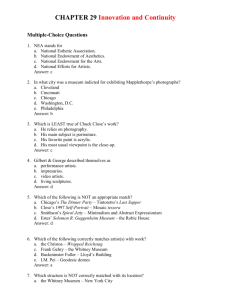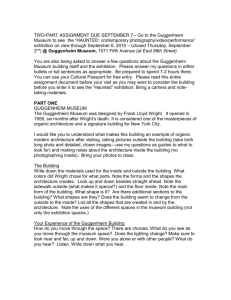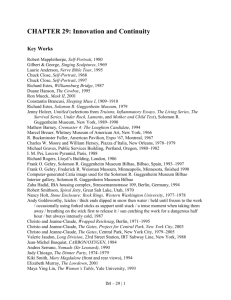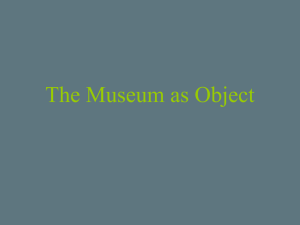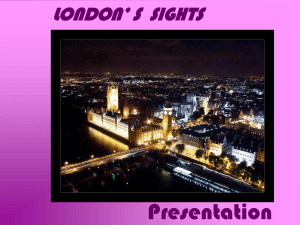Document 5223852
advertisement
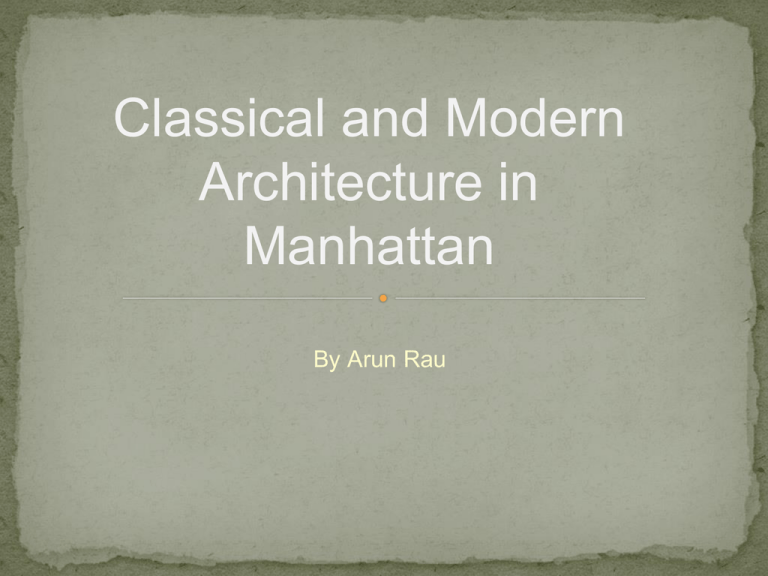
Classical and Modern Architecture in Manhattan By Arun Rau Part 1 Classical Architecture 2 The Dakota— former home to John Lennon A BottomView of The Dakota A Bottom View of The Dakota 4 The Metropolitan Museum of Art—from an angle 5 The Metropolitan Museum of Art (front side view) 6 The Belvedere Castle of Central Park Part 2 Modern Architecture 8 8 Spruce Street (formerly known as the Beekman Tower) The Hearst Tower The IAC HQ The Solomon R. Guggenheim Building Descriptions, Histories and More Slide 1: The Dakota, constructed from October 25, 1880 to October 27, 1884, is a co-op apartment building located on the northwest corner of 72nd Street and Central Park West in the Upper West Side of Manhattan in New York City, at 1 West 72nd Street, New York, NY 10023. It is infamously known for being John Lennon’s deathbed—where he was shot and killed. The Dakota is also famous for being the home at one point or another of many other celebrities—Judy Garland, Yoko Ono, Lauren Bacall, Leonard Bernstein, Rex Reed, William Inge, and Connie Chung. Henry Janeway Hardenbergh was the architect. Slide 2: The Metropolitan Museum of Art is the largest art museum of art in the United States, and one of the three largest in the world, holding more than 2 million works. The Metropolitan Museum of Art was founded in 1870 by a group of American citizens. The founders included businessmen and financiers, as well as leading artists and thinkers of the day, who wanted to open a museum to bring art and art education to the American people. It opened on February 20, 1872, and was originally located at 681 Fifth Avenue. Richart Howland Hunt, Jacob Wrey Mould, Calvert Vaux, Richard Morries Hunt and Kevin Roche were the architects. Slide 6: Belvedere Castle, another landmark, located adjacent to Turtle Pond in Central Park means “beautiful view” in Italian. Originally designed in 1865 by Calvert Vaux and Jacob Wrey Mould, Belvedere Castle was intended to be a Victorian Folly, a fantasy structure that provides a great backdrop and views, but without a real intended purpose. With its strong stone façade, grand turret and flag, the castle was merely a stunning attraction in Central Park. 8 Spruce Street, originally known as Beekman Tower and currently marketed as New York by Gehry, is a 76-story skyscraper designed by architect Frank Gehry.in the New York City borough of Manhattan at 8 Spruce Street in Lower Manhattan, just south of City Hall Plaza and the Brooklyn 13 Bridge. 8 Spruce Street, originally known as Beekman Tower and currently marketed as New York by Gehry, is a 76story skyscraper designed by architect Frank Gehry.in the New York City borough of Manhattan at 8 Spruce Street in Lower Manhattan, just south of City Hall Plaza and the Brooklyn Bridge. Hearst Corporation's global headquarters and the first New York City landmark of the 21st century. Using the original 1928 Hearst International Magazine Building as his pedestal, noted British architect Norman Foster has conceived an arresting 46-story glass-and-steel skyscraper that establishes a number of design and environmental milestones. Hearst Tower is a true pioneer in environmental sustainability, having been declared the first "green" office building in New York City. Located in the West Chelsea neighborhood of New York City, across from the Chelsea Piers and entertainment complex, The building is the NYC flagship building for the company. The new IAC headquarters is a nine-story concrete tower with a sculpted glass facade. The glass facade of the concrete structure is insulated with a special coating that has patterned ceramic particles imbedded in it to improve energy efficiency. It was designed by Frank Gehry Designed by Frank Lloyd Wright, the cylindrical museum building, wider at the top than the bottom, was conceived as a "temple of the spirit" and is one of the 20th century's most important architectural landmarks. The building opened on October 21, 1959, replacing rented spaces used by the museum since its founding. The museum was established by the Solomon R. Guggenheim Foundation in 1939 as the Museum of NonObjective Painting, under the guidance of its first director, the artist Hilla von Rebay. It adopted its current name after the death of its founder, ,Solomon R. Guggenheim, in 1952. The museum was established by the Solomon R. Guggenheim Foundation in 1939 as the Museum of Non-Objective Painting, under the guidance of its first director, the artist Hilla von Rebay. It adopted its current name after the death of its founder, Solomon R. Guggenheim in 1952. 14 Bibliography Wikipedia.com Nytimes.com Centralpark.com Nymag.com Google.com Arcspace.com 15 Ever wonder why you see new construction sites that you haven’t seen before, an apartment building in scaffolds, or an office building in frames? There is a simple explanation: New York City is always changing very fast—renovating, rebuilding, polishing—but the buildings that hold importance are usually kept. These buildings are the survivors that have escaped any demolishment and cling to special remembrances and various significances. For example, Castle Clinton’s significance was to guard New York from British forces during the Revolutionary War. It was not destroyed because it reminded people of the fight with the British they won, which is basically pride of the country. All of these buildings represent something, modern or old. Modern and old architecture obviously have differences, but they do have some similarities. One big difference between modern and classical architecture is the materials used in the buildings. It was not until the last century that glass and steel became common. Modern architecture is usually made of simple and flat designs. Classical architecture is another story when talking about the complication. Classical buildings usually have intricate and detailed composition. Similarities between modern and classic architecture do not have to do with anything visual. A lot of times, you can find two totally visually different buildings but they could stand for the same reason, or hold the same meaning or feeling. For example, the MET Museum and the Guggenheim Museum both are museums, but one is modern and one is classic. Generally speaking, there are less similarities between modern and classical architecture than differences, but the differences explain the change, which makes them very compelling. You usually don’t see a glass and steel structure with Roman columns. Yes, modern and classical architecture have been conjoined in the past, but rarely. Why did architecture change? Previously, many buildings have been made of wood, stone and bricks. But modern architecture was a celebration of technology—steel, glass and iron were not available back then. So the era of modern architecture came in when people discovered these new materials. 16



